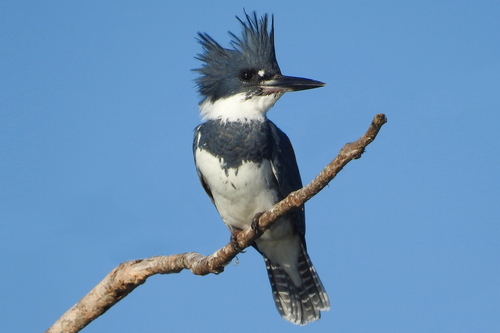
Belted Kingfisher
The Belted Kingfisher (Megaceryle alcyon) is a striking, medium-sized bird widely recognized for its shaggy crest, large head, and powerful bill. It is a common sight near water bodies across North America, often perched on branches or wires, scanning for prey. This kingfisher plays a crucial role in its ecosystem as a top predator of small fish and aquatic invertebrates, helping to regulate their populations. While not typically considered culturally significant in the same way as some other birds, its distinctive appearance and rattling call make it a familiar and easily identifiable species for birdwatchers and nature enthusiasts.
28-35 cm
Length
48-58 cm
Wingspan
Least Concern
Conservation Status
Distribution
The Belted Kingfisher is found throughout North America, breeding from Alaska and Canada south to the southern United States. During winter, northern populations migrate south, extending the species' range into Central America, the Caribbean, and northern South America. They typically reside near bodies of water, both freshwater and saltwater.
Lifespan
The average lifespan in the wild is 6-8 years, but some individuals have been recorded living up to 14 years.
Belted Kingfisher's Habitat
Habitat Types
Rivers, Streams, Lakes, Ponds, Estuaries, Coastal areas
Climate Zones
Temperate, Subtropical, Tropical
Adaptations
Belted Kingfishers require clear water to spot prey and earthen banks or cliffs for nesting. Their specialized eyes allow for excellent underwater vision, and their strong bill is adapted for capturing and holding slippery fish. They can tolerate a range of water salinities.
Variations
There are subtle regional variations in size and plumage, but no widely recognized subspecies.
Appearance
Breeding Plumage
Plumage is generally consistent year-round.
Seasonal Feather Changes
Minimal seasonal variation. Juveniles have a rustier band across their breast.
Sex Based Plumage Differences
Males have a single blue-gray breast band. Females have a blue-gray breast band and a chestnut band below it, extending down the flanks.
Notable Features
Shaggy crest on the head, Large, powerful bill, Blue-gray upperparts, White underparts with a prominent breast band, Short legs
Diet and Feeding
Primary Foods
Small fish, Crustaceans, Amphibians, Aquatic insects, Small reptiles
Foraging Behavior
Belted Kingfishers typically hunt by perching on a branch or wire overlooking water. They dive headfirst into the water to capture prey, often hovering briefly before plunging. They may also forage by flying low over the water.
Specializations
Their eyes have specialized adaptations for underwater vision, allowing them to accurately judge the depth and location of prey. Their strong bill is designed for grasping and holding slippery fish.
Seasonal Diet Variations
Diet may shift slightly depending on prey availability. In winter, when fish may be less active, they may consume more crustaceans and other invertebrates.
Behavior
Social Structure
Belted Kingfishers are generally solitary, except during the breeding season when they form monogamous pairs. They are highly territorial.
Communication
Loud, rattling call, Chattering calls, Visual displays (e.g., raising and lowering the crest)
Migration
Northern populations are migratory, moving south for the winter. Southern populations are generally resident year-round. Migration is often along coastlines or waterways.
Territorial or Group Behaviors
They aggressively defend their feeding and nesting territories from other kingfishers. Territories are typically linear, along a stretch of shoreline.
Conservation
Threats
Habitat loss (due to development and water pollution), Water pollution (reducing prey availability and water clarity), Human disturbance (near nesting sites), Collisions with vehicles and structures
Protection Programs
General wildlife protection laws (e.g., Migratory Bird Treaty Act in the US), Habitat restoration and conservation efforts
Local National Laws
Protected under the Migratory Bird Treaty Act in the United States, Canada, and Mexico.
Population Trend
Stable
Population Estimates
The global population is estimated to be around 1.7 million individuals.
Interesting Facts
Belted Kingfishers are one of the few bird species where the female is more brightly colored than the male.
The female's additional chestnut band distinguishes her from the male.
They often regurgitate pellets of indigestible material, such as fish bones and scales.
These pellets can be found near their perches and provide information about their diet.
Their burrows can be up to 8 feet long.
This provides protection from predators and the elements.
They have been known to nest in unusual places, such as abandoned pipes or under bridges.
This demonstrates their adaptability to human-altered environments, although natural banks are preferred.
Faqs about Belted Kingfisher
What is the Belted Kingfisher's call like?
The Belted Kingfisher has a distinctive, loud, rattling call that is often heard before the bird is seen.
Where can I see a Belted Kingfisher?
Look for them near bodies of water, such as rivers, lakes, and coastal areas. They often perch on branches, wires, or other structures overlooking the water.
Do Belted Kingfishers migrate?
Northern populations migrate south for the winter, while southern populations are generally resident year-round.
Are Belted Kingfishers endangered?
No, the Belted Kingfisher is classified as Least Concern by the IUCN, meaning it is not currently considered to be at risk of extinction.
How do Belted Kingfishers catch fish?
They dive headfirst into the water from a perch or while hovering, using their sharp bill to grasp the fish.
Copyright @ Nature Style Limited. All Rights Reserved.
 English
English